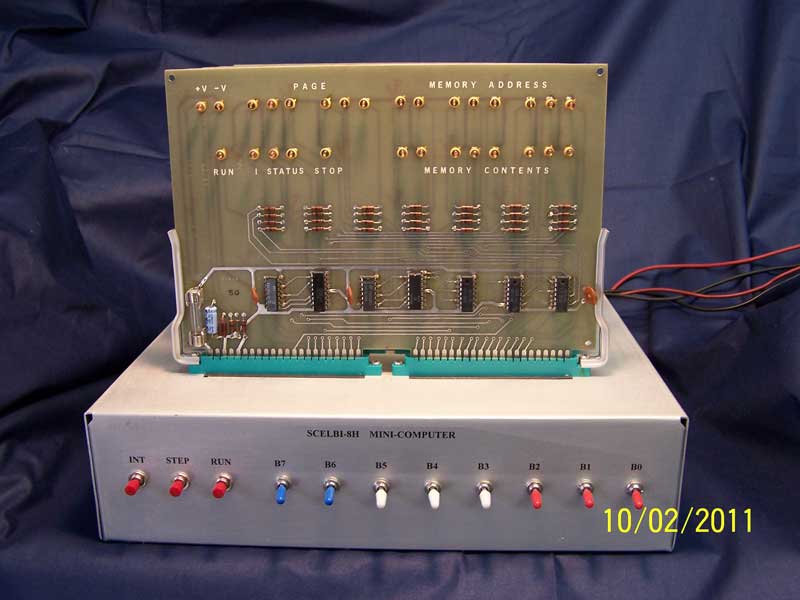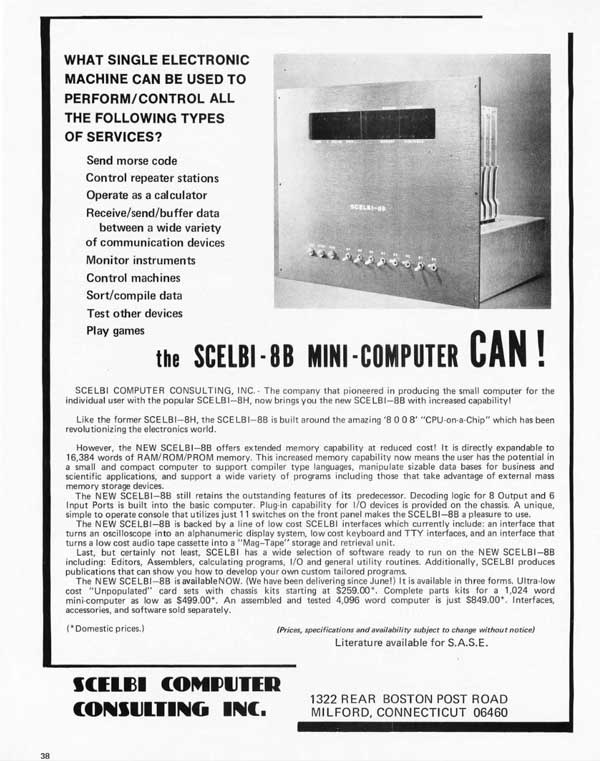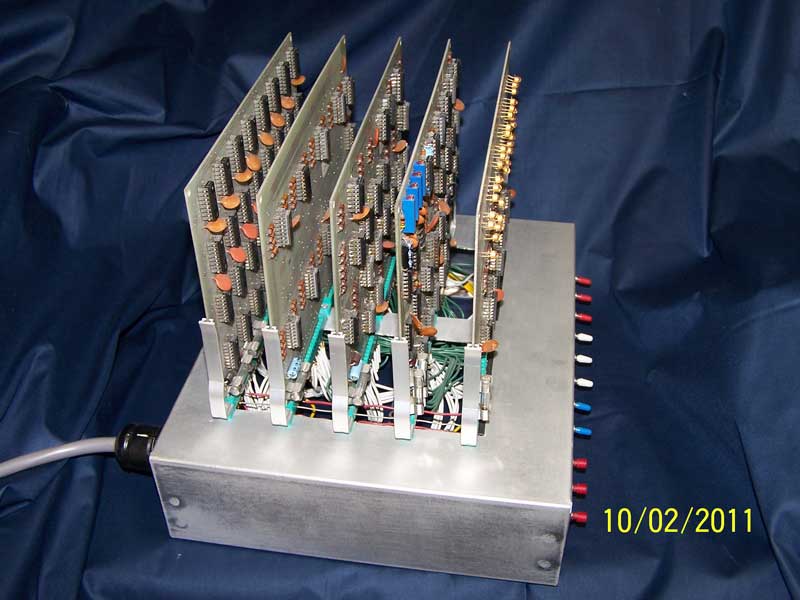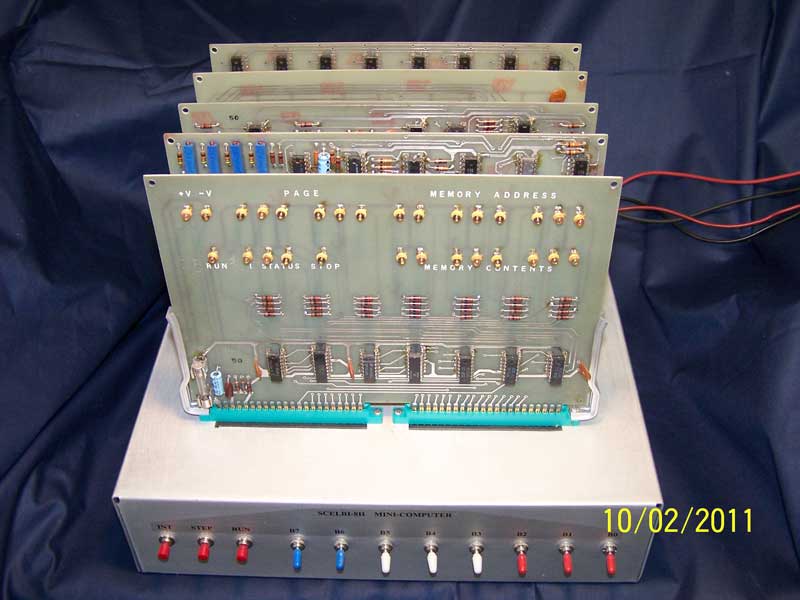The SCELBI Mini-Computer
About My Reproduction SCELBI and How to Build Your
Own SCELBI
I have a reproduction SCELBI 8H up and running and have boards sets
available for sale. Go to my SCELBI kit
page and/or follow my blog
to find out about my reproduction and what you need to do, to build
your own reproduction SCELBI.
About the SCELBI “Mini” Computer

SCELBI's came built - or as kits - this one was built from a bare
board kit
images of the SCELBI 8H provided by Curtis from Kentucky
The SCELBI (SCientic-ELectronics-BIology) was arguably the first
commercially available micro-computer marketed toward hobbyist.
The company name, SCELBI, which stands for
SCientic-ELectronics-BIology, clearly indicates that the business
clearly had a plan to penetrate specific markets which were not
necessarily hobby oriented. Frank Zawacki, an early employee,
recommends this site for a brief story about the founding of the
company. http://www.atarimagazines.com/creative/v10n11/6_The_early_days_of_persona.php
Frank told me, that SCELBI was incorporated and funded to the tune
of $100,000. Frank's father, helped raise money and managed
finances for SCELBI. They both worked for stock in those early
days.
The SCELBI computer business didn't survive for very long after the
advent of the incredibly inexpensive, 8080 powered, Altair.
SCELBI Computer Consulting found success publishing books and at one
point grew to employ 18 people.
The computer, itself, was built around the Intel 8008
architecture. There were two versions of the SCELBI.
SCELBI-8H
The first version was called the 8-H. The H standing for
hobbyist. It had the following features.
- 8 Slot backplane with the following cards:
- Front panel card
- CPU slot
- Data Buffer and Input slot
- Output port slot
- 4 Memory slots - up to 1K SRAM each slot for a total of
4K. It took 32 256 bit 1101 memory chips to make up 1K
bytes of memory that each board supported.
- On the back of the chassis was a panel which contained
- 8 8 bit parallel output ports
- 6 8 bit parallel input ports
- the power Supply connection

BYTE Magazine #1, September, 1975 had this ad for the SCELBI 8B
SCELBI-8B
The second version was called the 8-B. The B standing for
business. It had all the features of the 8H, but added
support for up to 16K of memory by adding an additional memory
addressing card and updating to 4K memory modules using 2102
memory.
- 9 Slot backplane with the following cards:
- Front panel card (same card as 8H)
- CPU card (same card as 8H)
- Data Buffer and Input card (same card as 8H)
- Output port card (same card as 8h)
- Memory expansion cart
- 4 Memory slots - up to 4K SRAM in each slot for a total of
16K. Each card could hold up to 32 1K bit 2102 memory
chips
- The chassis was essentially the same as the 8H, though the
extra slot in the backplane for the memory addressing card
took a bit more space in the top of the chassis
SCELBI Computer Consulting offered a power supply or the hobbyist
could find or build his own. SCELBI only sold about 20 of
their version of the power supply, so most hobbyists must have found
or built their own. The same power supply was used for both
the 8H and 8B, even though -9 volt amperage requirement was far less
on the 8-B. The 8-B's 2102 memory was 5 volt only,
dramatically reducing the load on the -9 volt supply.

Side View of Curtis's SCELBI-8H - only 1K of Memory is Installed
on this SCELBI (32 1101 SRAM chips on rear most board)

Another View of Curtis's SCELBI-8H
The default I/O capability was limited to the
extremely difficult to use front panel. Usage of the computer
involved switching 8 toggle switches to preset the value of
the address/data bus. The user would then clocking the CPU
with another toggle switch to step the 8008 cpu. During the
appropriate cycles, the 8008 would then read the data bus value as
set by the toggle switches as if it were reading memory or an I/O
location.
Expansion capability was through a series of
parallel ports on the back panel that made use of 11 pin vacumn
tube/relay sockets. Serial protocols could be implemented by
“bit banging” individual bits of this parallel port. There
were several standard expansion options including a cassette
interface, serial port and a terminal output device that made use of
an oscilloscope for display purposes. Detailed information on
these expansion devices is very difficult to find.
What Did They Say About SCELBI Computers "Back in the Day"
When SCELBI arrived to "market", except for the Amateur Computer
Society newsletter, there was no way for computer hobbyist to
share information. However, a number of clubs and newsletters
arrived on the scene as the Mark-8 and particularly the Altair hit
the newstands on the cover of widely distributed magazines.
Except for pricing issues, and later on, performance, as the
Altair's 8080 vastly outperformed the 8008, it's hard to find any
bad comments about SCELBI in those newsletters. Here are some
sample comments that I dug up. Note that Steve Ciarcia, is the
same person who latter wrote the Circuit Cellar column for Byte
magazine.
Mark-8 User Group Newsletter volume 1, #4, December 4th,1974
STEVE CIARCIA (address removed) HAS A LOT OF INTERESTING THINGS
GOING. HE STOPPED BY SCELBI'S OFFICE AND TOOK A LOOK AT THEIR
KITS AND PC BOARDS AND TALKED TO THE MANAGEMENT. HE WAS SO
IMPRESSED WITH THEIR DESIGN AND QUALITY THAT HE BOUGHT AN
UNPOPULATED BOARD SET FOR $130 AND SHOULD HAVE HIS MACHINE RUNNING
NOW....
Mark-8 User Group Newsletter volume 1, #5, Feburary 8th,1975
STEVE CIARCIA (address removed) HAS HIS SCELBI COMPUTER RUNNING AND
IS EVEN MORE ENTHUSIASTIC THAN BEFORE REGARDING THE QUALITY OF THE
BOARDS AND THE DESIGN OF THE SYSTEM. I'VE HEARD RUMORS THAT
THE PRICE OF THEIR BOARD SETS HAS BEEN REDUCED. THAT MAY NOW BE THE
BEST WAY TO GO. THEY DO PUBLISH A USER NEWSLETTER.
PERHAPS THEY OFFER THAT ON A SUBSCRIPTION BASIS.
Amateur Computer Society Newsletter Vol III, No. ll - March, 1975
Mini Micro Mart has this to say about other micros: "SCELBI is the
most expensive route and probably the best--surely the way to go if
you don't WANT to build your own, or even if you want to build your
own and have a minimum of technical software background. Good
boards, good design, and most important, FULL support, even to the
systems level ••••
Mark-8 User Group Newsletter volume 1, #9, August 3rd,1975
SCELBI CONTINUES TO ADD TO THEIR LEGION OF SATISFIED OWNERS. THEIR
MACHINE MAY NOT BE THE CHEAPEST OR THE PRETTIEST BUT IT IS EASY TO
ASSEMBLE, DOES EXACTLY WHAT IT IS SUPPOSE TO, DELIVERY IS ON TIME,
AND SUPPORT IS SUPERB. THEIR PROGRAMMING MANUALS CONTINUE TO EARN
ABSOLUTELY RAVE REVIEWS.
Cheat Sheet
Download this PDF
of an 8008/SCELBI Cheat Sheet.
For More Information
Cameron Cooper has made a great deal of interesting
information about SCELBI on his www.scelbi.com website. Among other
things, he has technical information including scematics, manuals
and board layout diagrams. This 8H
system description document, which can also be found on
Cameron's documentation page, is an original document used by the
founders, Nat Wadsworth and Bob Findley to describe the computer to
prospective customers. If you are interested in the SCELBI, I
highly recommend visiting his site.





